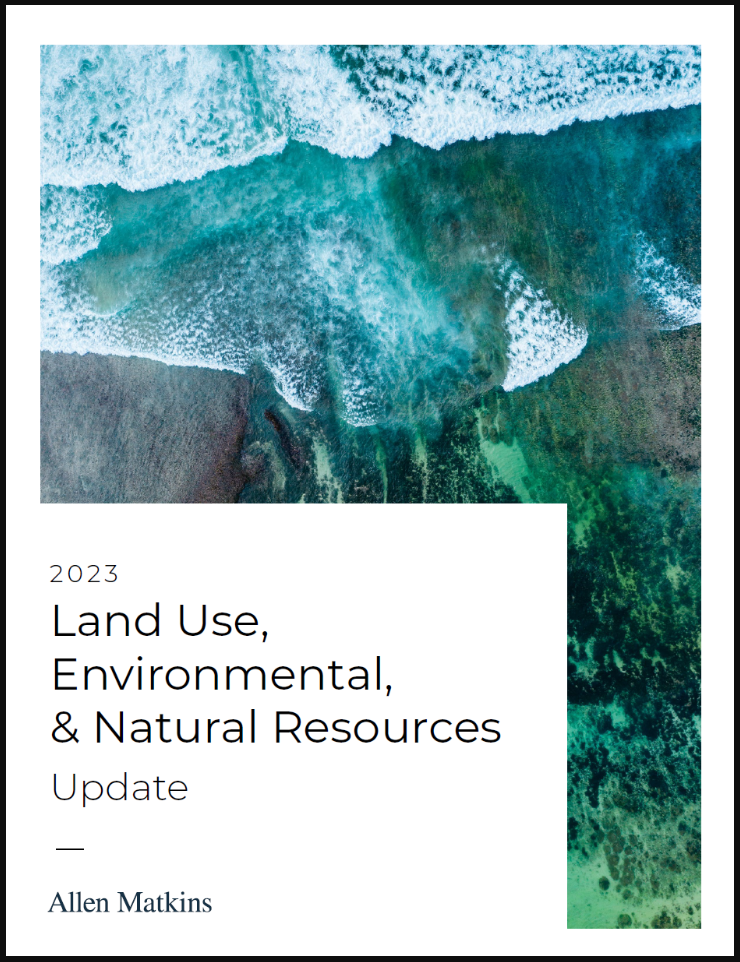News & Insights
2023 Land Use, Environmental, & Natural Resources Update

New California Housing Laws
Assembly Bill 2011 and Senate Bill 6 – Housing in Commercial Zoning Districts
Land Use
5.01.23
AB 2011 (Wicks) provides for “by right” streamlined ministerial (i.e., no CEQA) approval of qualifying mixed-income and affordable housing projects along commercial corridors in commercial zoning districts. This new law is expected to be a game-changer for multi-family housing developers providing on-site affordable housing. The new law will become operative on July 1, 2023 and will be in effect until at least January 1, 2033.
The following is a summary of the requirements that must be met under AB 2011 for mixed-income housing projects, along with a summary of the key differences between AB 2011 and SB 6 (Caballero), which also creates a pathway for the approval of qualifying housing projects in commercial zoning districts and will become operative on July 1, 2023. Please contact us for information about these bills, including applicable requirements for 100% affordable housing projects.
Key Insights and Open Issues
- Under AB 2011, the project must “meet or exceed” the greater of five enumerated residential density options, which is in turn the minimum residential density applicable to the qualifying property. AB 2011 provides that the “other” applicable objective zoning standards for the project shall be those for the closest zoning district that allows multifamily residential at that minimum density. AB 2011 is untested, and it is not clear from the statutory language whether the maximum density under those objective zoning standards also applies (prior to any density bonus). We expect the California Department of Housing and Community Development (“HCD”) and/or reviewing courts to weigh in accordingly.
- AB 2011 explicitly allows for a density bonus under the State Density Bonus Law (Gov. Code § 65915) to maximize the residential density on a qualifying property. AB 2011 also sets forth minimum affordability requirements. For example, if the project would meet AB 2011 requirements by including 15% low income units (as defined), the project would also qualify for a 27.5% density bonus under the State Density Bonus Law. AB 2011 also provides that only objective standards under a local ordinance implementing the State Density Bonus Law shall apply. Many local density bonus ordinances purport to require a separate discretionary approval, which would otherwise trigger CEQA review. The utilization of the State Density Bonus Law for a qualified AB 2011 project is untested. However, based on the statutory language in AB 2011, local jurisdictions should be prohibited from requiring a separate discretionary approval and CEQA review in this context. We expect HCD and/or reviewing courts to weigh in accordingly.
- AB 2011 prohibits residential units from being located within 500 feet of a freeway. At least two local jurisdictions have preliminarily determined that includes freeway on-ramps and off-ramps, which appears to be contrary to the intent of AB 2011. We expect HCD and/or reviewing courts to weigh in accordingly.
AB 2011 Requirements: Mixed-income Housing Projects
The following summary applies to housing projects that include a combination of affordable housing and market rate housing.
Threshold Requirements
- The project must be a multi-family housing project (five or more dwelling units).
- The project must consist of (i) residential units only, (ii) residential and nonresidential uses with at least two-thirds of the square footage designated for residential use, or (iii) transitional housing or supportive housing.
- Minimum density requirements must be met (see below).
Affordability Requirements
- For rental projects, either (i) 15% of the units must be lower income (as defined) or (ii) 8% of the units must be very low income and 5% of the units must be extremely low income (as defined), unless different local requirements apply.
- For ownership projects, either (i) 15% of the units must be lower income (as defined) or (ii) 30% of the units must be moderate-income (as defined), unless different local requirements apply.
- Where different local requirements apply, the project must include the higher percentage requirement and the lowest income target, unless local requirements require greater than 15% lower income units (only), in which case other specified requirements apply.
- For rental projects, the affordable units must be restricted for 55 years and for ownership projects, the affordable units must be restricted for 45 years.
- Affordable units in the project must have the same bedroom and bathroom count ratio as the market rate units, be equitably distributed within the project, and have the same type or quality of appliances, fixtures, and finishes.
Site Requirements
The project must be located on a site:
- 20 acres or less;
- within a zoning district where office, retail or parking are a principally permitted use;
- in an urbanized area or urban cluster (as defined and specified);
- that abuts a commercial corridor (as defined, with a right-of-way between 70 and 150 feet) and has at least 50 feet of frontage along that commercial corridor; and
- where at least 75% of the perimeter adjoins (as defined) parcels that are developed with urban uses (as defined).
The project must not be located on a site:
- where the proposed housing would be located within 500 feet of a freeway (as defined);
- where (or adjoins a site where) more than one-third of the square footage is dedicated to industrial use (as defined);
- that is prime farmland, a wetland, a very high fire hazard severity zone, a hazardous waste site, a delineated earthquake fault zone, a special flood hazard area, a regulatory floodway, conservation land, or habitat for protected species (as each is defined);
- currently occupied by existing restricted affordable units, restricted rent/price controlled units, or units occupied within the past 10 years (as each is defined) that would be demolished;
- previously used for occupied permanent housing that was demolished within the past 10 years;
- currently occupied by a historic structure listed on the national, state or local historic register that would be demolished;
- currently occupied by one to four existing dwelling units;
- that is vacant and (i) zoned for residential but not multi-family housing, (ii) contains tribal cultural resources and potential impacts cannot be mitigated (as specified), or (iii) is within a very high fire hazard severity zone (as defined);
- that is a designated mobile home, RV or special occupancy park (as specified);
- within a neighborhood plan area, unless that neighborhood plan permits multi-family housing and (i) was effective as of January 1, 2022 or (ii) was proposed (as specified) before that date and is adopted before January 1, 2024; or
- where the proposed housing would be located within 3,200 feet of a facility that actively extracts or refines oil or natural gas.
Labor Requirements
- All construction workers must be paid at least the general prevailing wage of per diem wages for the type of work in the geographic area (as specified), except that apprentices registered in approved programs (as specified) may be paid at least the applicable apprentice prevailing rate.
- The prevailing wage requirement must be included in all construction contracts, and all contractors and subcontractors must comply with specified requirements.
- If the project would include 50 or more dwelling units, additional requirements would apply (as specified), including but not limited to participation in an approved apprenticeship program and health care expenditures for any construction craft employees.
Housing Replacement and Relocation Assistance Requirements
- If the project would demolish one or more dwelling units, the project must replace those units.
- If any vacant or occupied protected dwelling units (as defined) would be demolished, specified requirements must be met, including but not limited to relocation assistance.
- Any applicable objective local regulations that are more protective of lower income households shall control, as specified.
Applicable Zoning, Subdivision, and Design Review Standards
- Must be objective (i.e., standards that involve no personal or subjective judgment and are uniformly verifiable to an external and uniform benchmark or criterion).
- The standard of review shall be whether there is substantial evidence that would allow a reasonable person to conclude that the development is consistent with the objective standards.
- Applicable standards shall be those standards in effect at the time that the development application is submitted to the local agency pursuant to AB 2011.
- Applicable standards shall be those for the closest zoning district that allows multi-family residential at the residential density described below. If no such zoning district exists, the applicable standards shall be those for the zoning district that allows the greatest density in the applicable city, county or city and county.
- The local agency may require that up to one-half of the ground floor of the project be dedicated to retail use, in which case that requirement cannot be modified through the density bonus process.
- If the project is deemed to be in conflict with applicable objective standards, the local agency must notify the project sponsor within 60 to 90 days of submittal of the development proposal, depending on whether the project contains more than 150 dwelling units. If the local agency fails to provide the required documentation (as specified), the project shall be deemed to satisfy applicable objective standards.
- Design review may be conducted by the local agency but must be objective (as specified) and must be concluded within 90 to 180 days of submittal of the development proposal, depending on whether the project contains more than 150 dwelling units.
Density Requirements and Height Limits
- The following density requirements are minimums, and may be exceeded pursuant to a density bonus under the DBL.
- In metropolitan jurisdictions (as defined), the minimum density shall be the greater of (i) the residential density allowed by local regulations (as specified), (ii) 80 units/acre for sites within one-half mile of a major transit stop (defined below), (iii) 60 units/acre for sites at least one acre in size and on a commercial corridor (as defined) at least 100 feet wide, (iv) 40 units/acre for sites at least one acre in size and on a commercial corridor less than 100 feet wide, or (v) 30 units/acre for sites less than one acre in size.
- The foregoing minimum density requirements under (ii)-(v) are reduced by 10 units (respectively) in non-metropolitan jurisdictions (as defined).
- The applicable height limit shall be the greater of (i) the height allowed by local regulations; (ii) 65 feet for sites within one-half mile of a major transit stop (as defined), within a city with a population greater than 100,000, and not within a coastal zone (as defined); (iii) 45 feet for sites on a commercial corridor (as defined) at least 100 feet wide; or (iv) 35 feet on sites on a commercial corridor less than 100 feet wide.
- A “major transit stop” is defined as: (i) an existing rail or bus rapid transit station; (ii) a ferry terminal served by either a bus or rail transit service; or (iii) the intersection of two or more major bus routes with a frequency of service interval of 15 minutes or less during the morning and afternoon peak commute periods.
Other Requirements
- Required notice to existing commercial tenants and required relocation assistance for qualifying commercial tenants, as specified.
- Required Phase I ESA and if a recognized environmental condition is found, specified requirements must be met.
- Required setback and street frontage requirements, as specified.
- Required bicycle parking pursuant to local regulations.
- Required EV and accessible/handicap parking spaces pursuant to local regulations, but off-street parking cannot otherwise be required.
Key Differences Between AB 2011 and SB 6
SB 6 will also become operative on July 1, 2023 and will likely serve as a fallback for housing developers where more extensive site and project requirements under AB 2011 would not be met, or where SB 35 could be utilized in conjunction with SB 6. Similar to AB 2011, SB 6 allows for the approval of qualifying housing projects in commercial zoning districts where office, retail or parking are a principally permitted use (i.e., without requiring a rezoning). However, it does not by its own terms provide for “by right” streamlined ministerial approval of those projects.
Rather, SB 6 amends SB 35 to allow project sponsors to invoke that law where a housing project would not otherwise qualify due to inconsistency with the underlying commercial zoning and objective zoning and design standards, provided that specified requirements are met. As explained in our prior legal alert, SB 35 separately provides for a streamlined ministerial approval process for qualifying housing projects in local jurisdictions that have not made sufficient progress towards their state-mandated Regional Housing Needs Allocation (RHNA), as determined by the California Department of Housing and Community Development (HCD).
SB 6 also expressly allows project sponsors to invoke protections under the Housing Accountability Act (HAA) for qualifying housing projects notwithstanding inconsistency with an applicable plan, program, policy, ordinance, standard, requirement, or other similar local provision. As explained in our prior legal alert, the HAA can be used as a tool to prevent a local agency from (i) applying its design or development standards to qualifying housing projects in a way that is overly restrictive or in a manner that is not an objective application of what the standards explicitly say in writing and (ii) denying or reducing the dwelling unit density of a qualifying housing project
Other key differences under SB 6 include but are not limited to:
- Extensive “skilled and trained workforce” requirements must be met in addition to prevailing wage requirements, subject to limited exceptions.
- No on-site affordable housing requirement (but any local requirements still apply), unless SB 35 is utilized in conjunction with SB 6.
- For mixed-use projects, 50% of the project square footage must be dedicated to residential use, the remainder of which must be allocated to retail commercial or office uses (hotel uses are prohibited). Note, however, that if SB 35 would be utilized, at least two-thirds of the square footage must be designated for residential use and other specified requirements must be met.
- Lower minimum density and less restrictive “urban area” requirements apply, as specified.
- The project must be consistent with any applicable sustainable community strategy or alternative plan, as described in Government Code section 65080.
Assembly Bill 2097 – Elimination of Parking Requirements
AB 2097 (Friedman), which took effect on January 1, 2023, is expected to benefit housing development (and other) projects. AB 2097 prohibits public agencies from imposing parking requirements on most development projects located within one-half mile of a major transit stop. A “major transit stop” is defined as: (1) an existing rail or bus rapid transit station; (2) a ferry terminal served by either a bus or rail transit service; or (3) the intersection of two or more major bus routes with a frequency of service interval of 15 minutes or less during the morning and afternoon peak commute periods.
AB 2097 establishes a “substantial hardship exception” that allows a public agency to impose parking requirements on an otherwise qualifying project if the public agency makes written findings, within 30 days of receipt of a completed application, that not enforcing parking requirements on the project would have a substantially negative impact, supported by a preponderance of the evidence in the record, on any of the following: (1) the public agency’s ability to meet its share of the regional housing need for low and very low income households; (2) the public agency’s ability to meet any special housing needs for the elderly or persons with disabilities identified in the applicable Housing Element; or (3) existing residential or commercial parking within one-half mile of the housing development project. Notably, the aforementioned “preponderance of the evidence” requirement sets a high bar for a public agency attempting to impose the exception.
Furthermore, a housing development project is not subject to the above exception if it satisfies any of the following: (1) it dedicates a minimum of 20% of the total units to very low, low, or moderate income households, students, the elderly, or persons with disabilities; (2) it contains fewer than 20 housing units; or (3) it is subject to parking reductions based on the provisions of any other applicable law (e.g., the State Density Bonus Law).
AB 2097 includes the following exceptions:
- AB 2097 does not eliminate local electric vehicle and accessible parking requirements for new multifamily residential and nonresidential development.
- Hotels, motels, bed and breakfast inns, and other transient lodging developments are not eligible for the benefits of AB 2097, except where a portion of a housing development project is designated as a residential hotel.
- An event center must provide parking, as required by local ordinance, for employees and other workers.
- Commercial projects subject to an existing development agreement with parking requirements are still subject to those requirements, provided that the required parking is shared with the public.
If a project provides parking voluntarily, a public agency may require: (i) spaces for care share vehicles; (ii) that spaces are shared with the public; and/or (iii) that parking owners charge for parking. A public agency cannot require that voluntarily-provided parking is provided to residents free of charge.
Authors
Partner
Associate
RELATED SERVICES
Allen Matkins Leck Gamble Mallory & Natsis LLP. All Rights Reserved.
This publication is made available by Allen Matkins Leck Gamble Mallory & Natsis LLP for educational purposes only to convey general information and a general understanding of the law, not to provide specific legal advice. By using this website you acknowledge there is no attorney client relationship between you and Allen Matkins Leck Gamble Mallory & Natsis LLP. This publication should not be used as a substitute for competent legal advice from a licensed professional attorney applied to your circumstances. Attorney advertising. Prior results do not guarantee a similar outcome. Full Disclaimer



